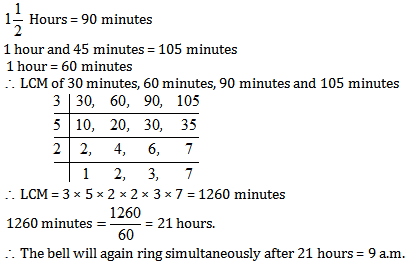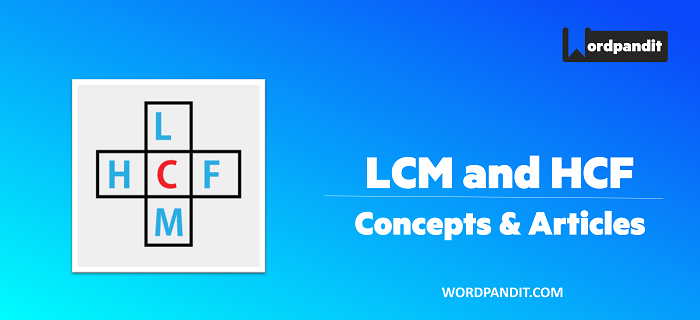Previously, we learned the concept of LCM and HCF. Also, we saw how to calculate LCM and HCF. It’s time we proceed further to see where does LCM and HCF find application.
Application of LCM:
TYPE 1: (When remainder is same)
In this type, a number N is divided by two or more divisors such that they give same remainders. Let a number N be divided by two divisors n1 and n2 such that remainder in each case is r then the number N must be in the form of k (LCM of n1n2) + r ,
So,
N = k(LCM of n1n2) + r
Example 1: Find the largest 3-digit number that gives remainder 3 when divided by 5 or 8.
Solution:
Step 1:- As per the given condition the number will be in the form of N = k(LCM of n1n2) + r i.e
N= 40k + 3, (LCM of 5 and 8 is 40 ).
Step 2:- The largest 3 digit number in the form of 40k i.e. 960.
Step 3:- So the largest 3 digit number that satisfy this condition = 960 + 3 = 963.
Example 2: Find the smallest number which when divided by 5 or 3 leaves a remainder 3 in each case.
Solution:
Step 1:- As per the given condition the number will be in the form of N = k(LCM of n1n2) + r i.e
N= 15 k + 3, ( LCM of 5 and 3 is 12 ).
Step 2:- we will get smallest number when k = 1 i.e., smallest number is 18.
TYPE 2: (When remainders are different)
In this type, a number N is divided by two or more divisors such that they give different remainders but the difference between the divisor and remainder is same in each case. Let a number N be divided by two divisors n1 and n2 that remainders are r1 and r2 respectively, and n1–r1=n2–r2 =x then the
N = k(LCM of n1n2) –x , where K is any +ve integer.
Example 3: Find the largest 3-digit number that gives 2 and 5 when divided by 5 and 8 respectively.
Solution:
Here in this case the difference between divisor and remainder i.e. 5 –3 = 8 –6 = 3. Since this difference is same, we can apply the Type 2 formula.
The number must be in the form of 40k – 3 since LCM of 5 and 8 is 40.
The largest 3 digit number will be in the form of 40k –3
25th multiple of 40 will be 1000; reducing 3 will give smallest 3-digit number fulfilling condition.
(40*25)-3 =997.
Number will be 997.
Example 4: Find the smallest 4 digit number that when divided by 3, 5 or 7 gives remainder 2, 4, and 6 respectively.
Solution:
Here 3 –1 = 5 – 3 = 7 – 5 = 1; that means the difference between divisor and remainder is same. Hence, any such number that satisfies the above condition must be in the form of
N = k(LCM of n1n2) –x ; n1–r1=n2–r2 =x
k(LCM of 3, 5 & 7) – 1, or 105 k – 1.
Now we need to find smallest 4-digit number that is multiple of 105.
When smallest 4-digit number i.e. 1000 is divided by 105 we get a remainder 55 that means 1000 – 55 = 945 is divisible by 105.
But that is the largest 3-digit number, and the next multiple of 105 is smallest 4-digit number that is divisible by 105.
So smallest 4-digit number that is divisible by 105 will be 945 + 105 = 1050
But the required form is105 k – 1.
So, the required number is 1050 – 1 = 1049.
Type 3 (neither the remainder nor the difference is same)
Let us understand this with the help of examples.
Example 5: Find the largest 3 digit number that gives remainder 1 and 5 when divided by 5 and 8 respectively.
Solution:
We know that dividend =divisor *quotient + remainder
Dividend = N
Divisor = d
Remainder = r
Quotient = q
So we can say that N= d*q + r
Now, according to question
N=5*a+1 …… (1)
N= 8*b+5 ……. (2)
As we know N/5 leaves remainder 1, so N must be in the form of 5*a +1
When the same number is divided by 8 then it leaves remainder 5 i.e. (5*a +1 )/N will give a remainder of 5
So we can say if we subtract 5 from the number .the number will be completely divided by 8
So (5x + 1) –5 = 5x – 4 must be divisible by 8.
Now we have to do trial and error method to find the minimum value of x such that 5x – 4 divisible by 8.
For x = 1, 5a – 4 = 1 (not divisible by 8)
For x = 2, 5a – 4 = 6
For x = 3, 5a –4 =11
For x = 4, 5a – 4 = 16, it is divisible by 8
Now at x = 4 ; N=5*a+1 will give us Smallest value of 21 that satisfies these conditions.
Now any number in the form of k(LCM of 5 and 8) + smallest Number
or 40k + 21 will satisfy this condition.
Then largest 3 digit number that satisfy these conditions are 960 + 21 =981.
Application of HCF:
TYPE 1:
The largest number which divides the numbers a, b and c and gives the same remainder is given by HCF of (a – b) and (b – c). Here, we are concerned with positive value of the difference.
Note: HCF of (a – b) and (b – c) = HCF of (a – b) and (a – c) = HCF of (b – c) and (a – c).
Example: When 302, 752 and 1502 is divided by N gives same remainder in each case then find the largest possible value of N.
Solution:
In this case, since remainder is same hence required number is HCF of (752 – 302) and (1502 – 752) or HCF of 450 and 750 and it is 150. Hence, largest value of N is 150.
TYPE 2:
The largest number by which the numbers a, b, and c are divided giving remainders as p, q, r respectively, then the largest number is given by HCF of three number (a –p), (b – q) and (c – r).
Example: Find the largest number by which when 182, 228 and 275 are divided remainders are 2, 3 and 5 respectively.
Solution:
Let the number be x.
Hence 182 – 2 = 180 is divisible by x and similarly 228-3= 225 and 275-5=270 is divisible by x .
So, largest value of x is given by HCF of 180, 225 and 270 and that is 45.
Try out some more examples:
Example 1: On a traffic signal, traffic light changes its color after every 24, 30 & 36 in green, red & orange light. How many times in an hour only green & red light will change simultaneously.
Solution:
L.C.M of 24 & 30 =120
So in 1 hr both green & red light will change 3600/120 times = 30 times
L.C.M of 24, 30 & 36 is 360
Hence in 1 hr all three light will change together 3600/360 = 10 times
So in 1 hr only red & green light will change 30 – 10 = 20 times simultaneously.
Example 2: Students of a class are preparing for a drill. If 7 students are arranged in a row then, 4 students are left out. If 9 students are arranged in a row, then 6 students are left out. If 21 students are arranged in a row then how many students will be left out?
Solution:
This is the question of LCM Type 2 questions. Here the difference 7 – 4 = 9 –6 = 3, hence any number in the form of 63k – 3 will satisfy this condition. When 63k – 3 is divided by 21 then remainder will be 21 – 3 = 18.
Let’s practice some more questions based on this concept.
EXERCISE:
Question 1. If the students of a class can be grouped exactly into 6 or 8 or 10, then the minimum number of students in the class must be
(1) 60
(2) 120
(3) 180
(4) 240
Answer and Explanation
Solution: (2)
If we need to group total number of students into sub group, total number has to be divided by every given number.
Therefore, the required number of students = LCM of 6, 8, 10 = 120.
Question 2. A number which when divided by 10 leaves a remainder of 9, when divided by 9 leaves a remainder of 8, and when divided by 8 leaves a remainder of 7, is :
(1) 1539
(2) 539
(3) 359
(4) 1359
Answer and Explanation
Solution: (3)
Number will be of the form
N = k(LCM of n1n2) –x , n1–r1=n2–r2 =x
Here, Divisor – remainder = 1 e.g., 10 – 9 = 1, 9 – 8 = 1, 8 – 7 = 1
So Required number = (L.C.M. of 10, 9, 8) – 1 = 360 – 1 = 359.
Question 3. When a number is divided by 15, 20 or 35, each time the remainder is 8. Then the smallest number is
(1) 428
(2) 427
(3) 328
(4) 338
Answer and Explanation
Solution: (1)
LCM of 15, 20 and 35 = 420
Number will be of the form N = k(LCM of n1n2) + r
So, the required least number = 420 +8 = 428.
Question 4. Four bells ring at intervals of 4, 6, 8 and 14 seconds. They start ringing simultaneously at 12.00 O’clock. At what time will they again ring simultaneously ?
(1) 12 hrs. 2 min. 48 sec.
(2) 12 hrs. 3 min.
(3) 12 hrs. 3 min. 20 sec.
(4) 12 hrs. 3 min. 44 sec.
Answer and Explanation
Solution: (1)
LCM of 4, 6, 8, 14 = 168 seconds = 2 minutes, 48 seconds
They ring again at 12hours + 2 min. 48 sec. = 12 hrs. 2 min. 48 sec.
Question 5. 4 bells ring at intervals of 30 minutes, 1 hour, 17: hour and 1 hour 45 minutes respectively. All the bells ring simultaneously at 12 noon. They will again ring simultaneously at;
(1) 12 mid night
(2) 3 a.m.
(3) 6 a.m.
(4) 9 a.m.
Answer and Explanation
Solution: (4)














